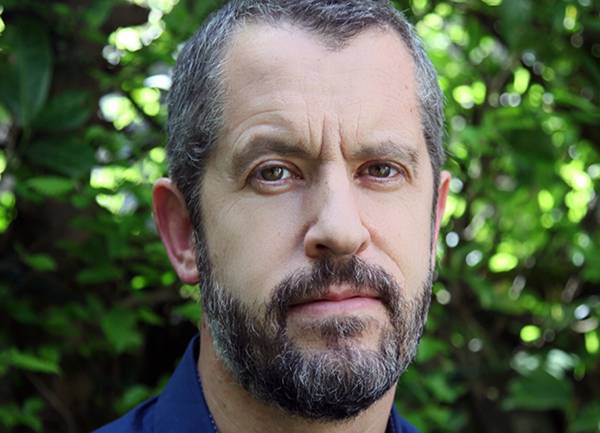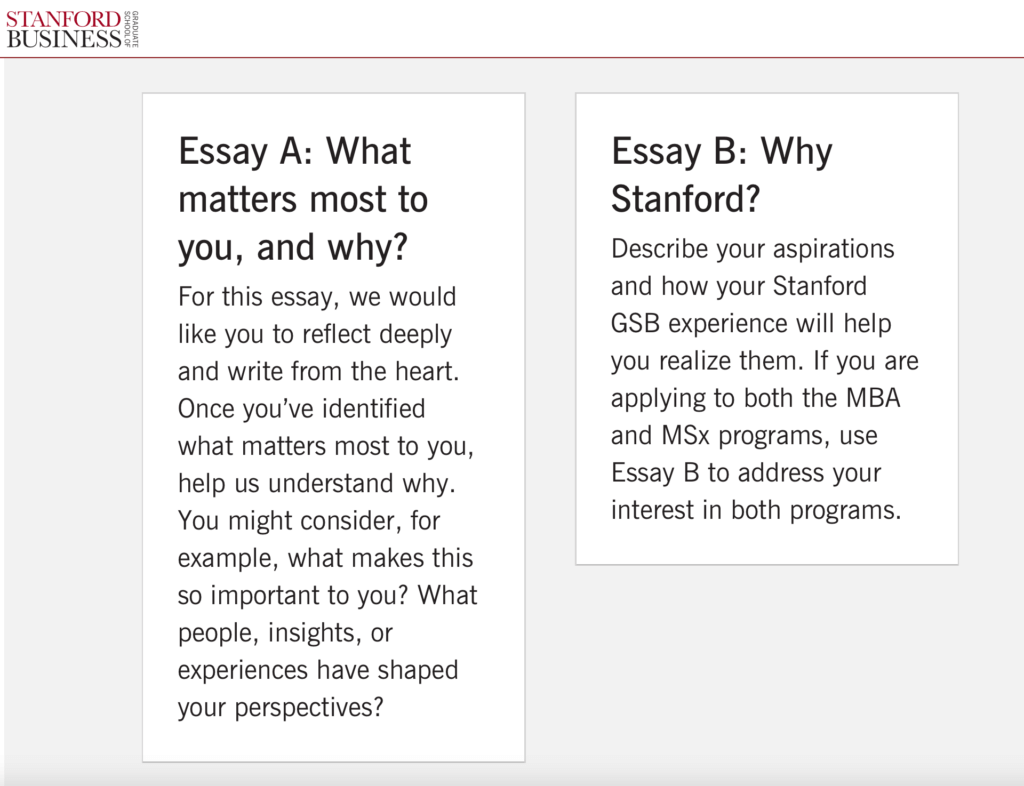Stanford GSB Essays: Tips & Strategy on Writing What Matters Most
July 31, 2024 |
The Stanford GSB essays continue to present a formidable exercise in self-awareness.
The Stanford GSB application esssays include two required questions and two optional short-answer questions. From these questions, the GSB wants to understand why we do the things we do, why we make certain choices in life, and the opportunities and challenges we face. Take this on as a personal feat, not just a series of MBA essay questions.
Rather than providing a hard word limit for each essay, the school sets a combined limit for both Stanford GSB essays at 1,000 words. They recommend up to 650 words for the iconic “What matters most to you and why” Essay A and up to 350 words for the “Why Stanford GSB?” essay. They say that they often find effective essays written in far fewer words.
By offering not just one but two optional short answer essays, the GSB is inviting you to get more personal in the main essay A, providing another space for you to detail your professional accomplishments and contributions. The second optional question, under Personal Information, invites you to elaborate on how your background or life experiences have helped shape your recent actions or choices
Stanford GSB Essay A
“What matters most to you and why?” (approx. 650 words)
This notorious question has become emblematic of the Stanford GSB essays, and typically ties applicants in knots as they try to come up with an answer that they hope is clever, striking or profound. The school is looking not just for extremely bright and successful individuals, but also people who have strong values and want to have a positive impact in the world. Taking the time to really think about this question provides invaluable insight into your life purpose and values. The “true you” that emerges from this introspection helps the GSB to evaluate your fit and and potential contribution to the class, which helps them select students forming a diverse and dynamic community.
Stanford suggests aiming to write 650 words/ Maybe you feel that you can answer the first part of the question in one word, with things like love, family or chocolate. But the heart of the question, the part that reveals your life’s calling and uniquely personal journey to get there, requires deeper introspection. Why does that one thing matter more than any other?
If you’re staring in terror at the blank page, Fortuna’s Tatiana Nemo, a Stanford GSB alumna and former MBA admissions interviewer, advises: “Invest some effort in building a timeline of the influences, instances and moments that have shaped you. Dig deep, connecting the dots between what has shaped you and who you’ve become. Devote essay A to talk about the past and present; talk about the future in essay B. Both essays need to be coherent and connected, so they could read as a single story.”
To best tackle the structure of this Stanford GSB essay question, start with identifying a person, event or experience that greatly impacted you, and think about the morals, values and lessons you gained from this experience or interaction. How do you use these lessons today, and how do they impact your drive, your motivation, and your vision of the world? The best Stanford GSB essays that worked in the past delivered a narrative that’s both personal and courageous in answering this question. (Fortuna coaches have sample Stanford GSB essays that have proven effective in the past.)
Even though you might have to spend hours on this essay brainstorming, researching, talking with others, writing a draft, and then another (and then another), just remember that it’s all inside you. It’s your story, and you just have to find it and pull it out.
Kirsten Moss, Stanford GSB’s former assistant dean of MBA admissions & financial aid, explained to Fortuna’s Matt Symonds why the GSB has stuck with this question for so long: “One of the things that has been proven over and over in research is that highly inspirational leaders who get the highest level of performance from their organizations really know what drives them, and they are thinking beyond themselves to the problems they can make change and have an impact on,” Moss told Symonds at a CentreCourt MBA Festival in San Francisco. “Taking the time to understand what matters to you will be your true north as a leader, no matter what school you go to, in the rest of your life… You will be one step ahead of the game in terms of being able to motivate others.”
For more guidance on this question, view my analysis in Forbes.
Why Stanford GSB Essay B
“Why Stanford? Describe your aspirations and how Stanford and your GSB experience will help you realize them.” (approx. 350 words)
If the first Stanford GSB essay is about your past and present, the second “Why Stanford GSB” essay is about your future. Stanford asks you to explain your decision to pursue graduate education in management and the distinctive opportunities you will pursue at Stanford. If you hope to create one of the best Stanford MBA essay examples, then your school research really needs to shine. What classes, clubs, events or other elements of the program and community will catalyze the impact you are aiming to make in the short, medium and long term? Dig deep and get specific; show Stanford that you’ve done more than just read about the different programs on the GSB website.
This is also where you should lay out career vision, in a highly focused and concise way. Beyond connecting the dots for your interviewer, you also really need to be specific to you. Fortuna’s Heidi Hillis, Stanford GSB alum and former alumni interviewer, advises her clients: “Look at every sentence and make sure no one else could have said it. Why do you need to be a better leader? In what way? How is the Stanford MBA and its offerings uniquely positioned to help? Consider specific aspects of your career vision when making the case to Stanford. If you have the room, potentially cite what kind of internship or post-MBA job you’re seeking.”
Optional Essay 1
“Think about times you’ve created a positive impact, whether in professional, extracurricular, academic or other settings. What was your impact? What made it significant to you or to others? You are welcome to share up to three examples.” (200 words for each example)
Introduced for the first time in 2019, this short answer question is a valuable invitation to reveal where you’ve been most impactful. You’ll do well not to consider it optional, and respond with with both substance and specificity. Behind this question is Stanford GSB’s belief that past behavior is the best predictor of future potential. It’s very likely your examples will appear in other parts of the application: a bullet on the resume, a story used to support the recommendation — even on the application itself, which asks you to talk about your “most significant accomplishment” for each job. The best Stanford GSB essay examples all went deeper with this question and didn’t repeat something that may be found elsewhere. Your responses should add value to your overall application. They should support the essays and the rest of the application, in highlighting why you find each circumstance to be impactful.
Stanford GSB Optional Essay 2
Tell us about a time within the last three years when your background influenced your participation in a situation, interaction, or project. (200 words)
This is a slight revision of a previously used Stanford GSB optional essau, which posed the question in the context of work or school. This wording invites you to draw upon a wider spectrum of situational examples or experiences. In this question, the GSB seeks to uncover the less visible forces that shape candidates’ lives, opportunities, decisions and achievements. This optional essay is a way for the admissions committee to recognize the challenges – or privileges – certain applicants face to get to where they are, even when students themselves may not see them as distinctive or noteworthy. Like the required essays, answering this question in an authentic and compelling way requires both substantial introspection and self-awareness. It’s a recognition that beyond your test scores, college transcripts, and career achievements, prospective students come from different backgrounds that shape both their decisions and actions in invisible ways. Similar to this Berkeley Haas optional essay, it’s a signal that the GSB wants to support the admissions committee’s decision-making by supplying a full and rich understanding of who each applicant truly is.
This question has always been part of the GSB application but has been elevated from a short-answer field on the form to an optional essay. Think of it as a place to talk about an aspect of your life that hasn’t been addressed anywhere else. The good news is that it can also take a more lighthearted turn, touching on a sport you’re involved in, your side gig in improv comedy, your training as a concert pianist. Be sure to show how this has shaped your presence and impact in the workplace.
When you understand and articulate what matters most to you, along with the forces that shape you, you’re claiming a self-awareness and clarity of purpose that set you up for success not just at business school, but also with relationships and career. Stanford wants to know what matters most to you, and so should you.
Let’s Get You In
Fortuna Admissions is a dream team of former MBA admissions directors and officers from top business schools, including Wharton. With our unparalleled collective expertise, we can help you develop a clear vision of your goals for business school and beyond. We work closely with you throughout the application process and provide expert guidance at every stage to maximize your chances of admission to a top school.
Our free consultations are consistently rated as the best in the industry. To learn more about Fortuna and get a candid assessment of your chances of admission to Wharton and other top programs, book your consultation session now.
Want more free advice?
View related articles by Fortuna’s expert coaches on Stanford GSB:
- MBA Admissions Masterclass: How to Get Into Stanford GSB (video)
- MBA Interview Prep for Stanford GSB + Example Behavioral Questions
- MBA Letters of Recommendation: Strategy for Stanford GSB & HBS
You can also view one of our top resources, the MBA Admissions Essay Masterclass featuring Stanford GSB, below.
All MBA Admissions Essay Masterclasses in our series, featuring insider advice from former gatekeepers of the world’s top business schools, are available on Fortuna’s YouTube channel.
 Fortuna Admissions Co-Founder and Director Matt Symonds is business education industry expert and columnist for Forbes, The Economist, BusinessWeek and the BBC, among other publications.
Fortuna Admissions Co-Founder and Director Matt Symonds is business education industry expert and columnist for Forbes, The Economist, BusinessWeek and the BBC, among other publications.
For more free advice and a personal, candid assessment of your chances,
sign up now for a free consultation.

